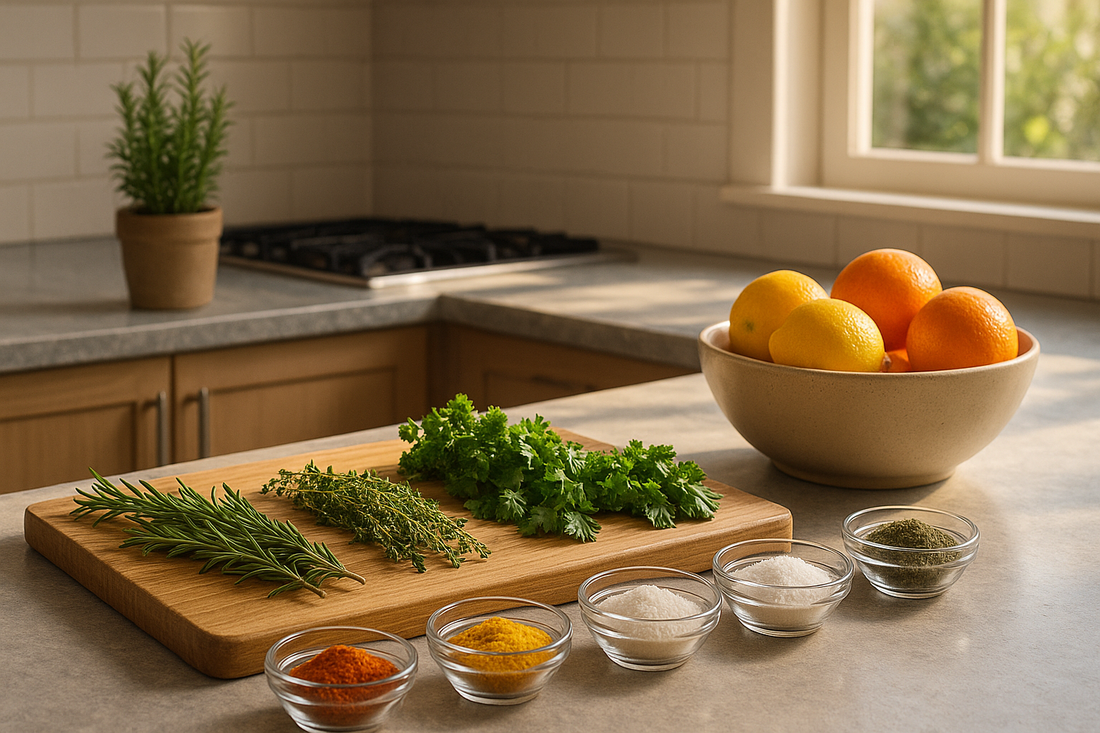
How to Reduce Sodium in Cooking Without Losing Flavor
Share
Did you know over 70% of sodium in our diets comes from packaged foods? Reducing sodium can lower blood pressure, improve bone health, and enhance medication effectiveness. But cutting back on salt doesn’t mean sacrificing flavor. Here’s how you can cook delicious, low-sodium meals:
- Use herbs and spices: Basil, thyme, rosemary, cumin, and turmeric add depth without salt.
- Add acidity: Citrus (lemon, lime) and vinegars brighten flavors.
- Boost umami: Mushrooms, tomato paste, nutritional yeast, and low-sodium soy sauce create savory richness.
- Master cooking techniques: Browning, caramelization, and layering flavors enhance taste naturally.
- Try low-sodium sauces: Options like balsamic glaze or garlic-parm sauces pack flavor with less sodium.
Your taste buds adjust to lower sodium in just 10–14 days. Start small by halving salt, then experiment with these strategies for heart-healthy, flavorful meals.
10 Ways to Flavor Your Meals Without Salt
How Salt Works in Cooking
Grasping the role of salt in cooking is essential for cutting back on sodium without sacrificing flavor. Salt is made up of roughly 40% sodium and 60% chlorine[1].
Flavor Enhancement: Salt has a unique ability to elevate flavors. It reduces bitterness while enhancing sweet, sour, and umami notes[2]. That’s why even desserts like cookies or chocolate benefit from a pinch of salt - it boosts their natural sweetness without making them taste salty.
Aroma Boost: Salt also strengthens aroma. By lowering water activity in food, it concentrates flavors and helps release aroma compounds that make dishes more enticing[1][3].
"Salt is used as a universal flavour improver because at low concentrations it will reduce bitterness, but increase sweet, sour and umami, which is desirable for sweet recipes. But at higher concentrations it suppresses sweetness and enhances umami, which is good for savoury things." - Luis Villazon[2]
Texture Modification: Salt plays a key role in altering texture by interacting with proteins and moisture. Here’s how it works across different foods:
| Food Type | How Salt Affects Texture |
|---|---|
| Meat | Breaks down proteins, making it more tender and helping it retain moisture during cooking[4] |
| Bread | Strengthens gluten, resulting in better texture and structure[4] |
| Cheese | Removes excess moisture, ensuring the right firmness[5] |
Flavor Balancing: Beyond enhancing flavors, salt also balances dishes by masking unwanted notes and rounding out the overall taste profile[3].
This foundation is crucial for exploring ways to replace salt with other ingredients and methods while maintaining its essential flavor-boosting qualities.
Top Salt Substitutes for Cooking
Herbs and Spices Guide
A 2024 study revealed that swapping out salt for herbs and spices reduced sodium intake by 800 mg daily, contributing to better blood pressure management [6].
Fresh vs. Dried Herbs:
- When using fresh herbs instead of dried, triple the amount for a comparable flavor. Add them toward the end of cooking to retain their aroma and taste.
- To keep herbs fresh, store them in airtight containers away from heat and direct sunlight [8].
| Herb/Spice | Best Uses | Flavor Profile |
|---|---|---|
| Basil | Italian dishes, tomato sauces | Sweet, aromatic |
| Thyme | Roasted vegetables, chicken | Earthy, minty |
| Rosemary | Roasted meats, potatoes | Pine-like, robust |
| Cumin | Curries, rice dishes | Earthy, warm |
| Turmeric | Rice, curries, marinades | Earthy, vibrant |
In addition to herbs and spices, incorporating acidic ingredients can elevate flavors without the need for extra salt.
Cooking with Citrus and Vinegars
Citrus fruits and vinegars are excellent for enhancing flavor while cutting back on salt [10].
Citrus Tips:
- Add lemon zest to sauces and soups for a fresh, bright note.
- Use lime juice in marinades for chicken and fish to enhance flavor.
- Toss orange segments into salads for a natural touch of sweetness.
Vinegar Applications:
- Add a small splash (less than 1/8 teaspoon) of vinegar to dishes at the end of cooking for a finishing touch [9].
- Use vinegar in marinades to tenderize meats [9].
- Drizzle balsamic vinegar over roasted vegetables to bring out their natural sweetness [10].
Acidic ingredients not only enhance flavors but also pave the way for incorporating umami, a savory element that further reduces the need for salt.
Using Umami-Rich Foods
Umami adds a savory depth that minimizes the need for salt. Dr. George Thomas, a hypertension specialist, recommends: "Try using natural substitutes like lemon, ginger, curry, dried herbs (such as bay leaves, basil and rosemary), onion, garlic and dry mustard" [6][7].
Natural Umami Sources:
- Mushrooms, particularly dried shiitake
- Tomato paste
- Nutritional yeast
- Low-sodium soy sauce, which contains 40% less sodium than regular soy sauce [12][13]
- Aged cheeses
Combining umami-rich ingredients can create a deeper, more complex flavor. Food scientist Nik Sharma highlights that gradually reducing salt in your diet can increase your sensitivity to it over time, making it easier to enjoy reduced-sodium meals [12].
Basic Cooking Methods to Reduce Salt
You don’t always need salt to make food taste amazing. In fact, using smart cooking techniques and the right ingredients can cut added sodium by up to 50% while keeping flavors rich and satisfying [11].
Step-by-Step Flavor Building
Building flavors layer by layer is a great way to create depth in your dishes without depending on salt. Here’s how you can do it:
| Cooking Stage | Ingredient Addition | Timing |
|---|---|---|
| Base Layer | Aromatics (onions, garlic) | First 5–10 minutes |
| Middle Layer | Dried herbs, spices | Once the aromatics soften |
| Final Layer | Fresh herbs, acids | Last 1–2 minutes or after cooking |
By adding ingredients in stages, you allow each to develop its unique flavor before moving on to the next. Once you’ve mastered this, heat techniques can take things to the next level.
Browning and Caramelization Tips
When you apply heat, magic happens. At 250°F, proteins react with sugars to create toasty flavors, while above 330°F, sugars caramelize into sweet, nutty notes [14]. These processes unlock incredible depth in your food.
How to Perfect Browning:
- Dry ingredients first: Pat them dry to help browning along [14].
- Preheat your pan: A hot surface ensures even cooking [15].
- Don’t overcrowd: Give ingredients space to brown evenly [15].
- Deglaze for flavor: After browning, add a splash of liquid to the pan to lift those flavorful bits [14].
These techniques not only enhance flavor but also make your dishes feel more indulgent - without extra salt.
Ingredient Prep Methods
How you prepare your ingredients can also make a huge difference. Marinating, for example, is a fantastic way to infuse flavor while keeping sodium low. Here’s a quick guide to marinating times:
- Fish: 30 minutes
- Lean meats: 30 minutes to 4 hours
- Chicken pieces: 30 minutes to 6 hours
- Whole chicken or tougher cuts: 4 to 12 hours [17]
Use a mix of citrus or vinegar, oil, and spices to tenderize and flavor your proteins. This method not only enhances taste but also keeps your meals juicy and satisfying.
"Marination is the process of soaking foods in a seasoned, often acidic, liquid before cooking... In order to achieve the same effects of tenderization and imbuing flavor that salt does in a brine, we need a liquid that is either acidic or enzymatic."
sbb-itb-f97e3b5
Low-Sodium Sauce Options
When working to reduce salt in your cooking, low-sodium sauces can be a game-changer. They bring bold flavors to your meals without relying on extra salt. Choosing sauces designed for flavor-packed results can make all the difference.
Taste Flavor Co Sauce Guide

Taste Flavor Co has created a line of low-calorie, low-sodium sauces that deliver big on taste. Each serving is just 10 calories or less, making them a great addition to your pantry:
| Sauce Flavor | Best Uses | Flavor Profile |
|---|---|---|
| Spicy Garlic Parm | Chicken, pasta, vegetables | Savory with a bold garlic and spicy kick |
| Hot Honey Sriracha | Stir-fries, marinades, dips | Sweet heat with a hint of Asian flair |
| Buffalo Blue Cheese | Wings, sandwiches, wraps | Tangy with a mild, spicy undertone |
| Sweet Honey Mustard | Salads, proteins, dipping | Sweet and tangy with a touch of spice |
| Cherry Smoked BBQ | Grilled meats, glazes | Sweet and smoky with fruity accents |
Made with real, high-quality ingredients, these sauces are versatile enough to be used as marinades, condiments, or seasonings. Incorporating them into your cooking can elevate your dishes with minimal effort.
Sauce Usage Tips
Marinating
Combine low-sodium sauces with citrus juice and fresh herbs to create flavorful marinades. For example, marinate fish for about 30 minutes or chicken for up to 6 hours to infuse it with flavor.
Building Layers
For deeper flavor, layer sauces throughout your cooking process:
- Start with a small amount during cooking.
- Add another layer near the end of the cooking time.
- Finish with a fresh drizzle right before serving.
Smart Substitutions
"Fresh and prepared at-home meals are your best choice to limiting sodium intake. Americans get about 70 percent of their daily sodium from processed and restaurant foods. Creating your own meals allows you to add spices and herbs that flavor your food without adding sodium, extra fat, and calories."
– Casey M. Richardson, RD, Lee Health clinical dietitian [18]
Sauce Enhancement Techniques
Take your low-sodium sauces to the next level with these simple tricks:
- Add fresh citrus zest for a burst of brightness.
- Mix in fresh herbs like parsley, cilantro, or basil for added depth.
- Use a splash of vinegar or citrus juice to balance sweetness.
- Blend sauces with Greek yogurt for creamy dips or dressings.
These techniques not only enhance the flavor but also give your dishes a fresh, homemade touch.
Steps to Cut Salt Gradually
If you're aiming for healthier cooking without sacrificing flavor, gradually reducing salt is a practical approach. The good news? Your taste buds can adapt in just 10–14 days, making the transition smoother than you might expect [22].
Training Your Taste Buds
Cutting back on sodium successfully means easing into the change. Research suggests it takes about 6–8 weeks for your palate to fully adjust [20]. Here's a simple 8-week plan to help you make the shift:
| Weeks | Salt Usage | Tips to Boost Flavor |
|---|---|---|
| 1–2 | Cut your usual salt use by half | Experiment with herbs and spices |
| 3–4 | Reduce salt to 25% of your usual amount | Add citrus juices or vinegars for brightness |
| 5–8 | Stick to the reduced salt level | Enjoy your new, low-sodium flavor profile |
"Over time, your body adapts to accepting lower sugar or lower salt, and you'll get the same signal that 'this tastes good' or 'this is the right balance of flavors,' as you did before when it was higher." – Dr. Maya Vadiveloo, Associate Professor of Nutrition at the University of Rhode Island [19]
Once you've adjusted, tracking your sodium intake can help solidify these changes and keep you on track.
Sodium Tracking Basics
Monitoring your daily sodium intake doesn't have to be complicated. Here are a few simple strategies:
- Use a smartphone app to log sodium levels in your meals.
- Check nutrition labels carefully, paying close attention to serving sizes.
- Account for all sources of sodium, including condiments and seasonings.
- Remember: Processed foods contribute over 70% of the sodium in most diets [21].
To make even more progress, try these smart swaps:
- Replace salt with fresh herbs when cooking.
- Brighten dishes with citrus juices or vinegars instead of salt.
- Opt for fresh produce instead of canned goods.
- Rinse canned foods to cut sodium by up to 40% [16].
Conclusion: Making Low-Sodium Food Taste Good
Lowering sodium in your diet doesn’t mean giving up on flavor. In fact, studies suggest that over time, people who adopt a lower-sodium diet begin to develop a preference for it[16]. The key lies in mastering techniques that bring out bold, satisfying flavors without relying on salt.
Cooking from scratch is one of the best ways to manage sodium intake. George Thomas, MD, a Hypertension Specialist, emphasizes the health benefits:
"Studies show that cutting down on sodium in your diet can lower blood pressure - reducing your risk of stroke, heart failure and other health problems."[6]
By using smart strategies, you can enhance taste while keeping sodium levels low. Here are some practical methods to try:
| Method | Taste Boost | How to Use It |
|---|---|---|
| Herb & Spice Blends | Reduces sodium by up to 50% | Experiment with dried herbs like basil, rosemary, or bay leaves. |
| Natural Acids | Brightens flavors | Add a splash of fresh citrus juice or a drizzle of vinegar. |
| Umami Boosters | Adds savory depth | Use ingredients like mushrooms and tomatoes for richness. |
For even more variety, consider products like Taste Flavor Co's low-calorie sauces. Options like Cherry Smoked BBQ or Hot Honey Sriracha can bring exciting flavors to grilled proteins, while Spicy Garlic Parm works wonders on roasted vegetables - all without overloading on sodium.
Adjusting to a lower-sodium lifestyle is a gradual process. As the FDA explains:
"We know that people usually don't notice small reductions (about 10 percent) in sodium. And, over time, people's taste buds get used to these changes, especially if they are made gradually."[23]
With these techniques, you can create meals that are both delicious and heart-healthy.
FAQs
What’s the best way to track my sodium intake when using low-sodium cooking methods?
To keep tabs on your sodium intake, start by jotting down everything you eat and drink in a food diary or a note-taking app. Check nutrition labels carefully - they show the sodium content per serving, which is key to staying aware of how much you're consuming each day.
If you prefer a tech-savvy solution, try a smartphone app designed for tracking sodium. These apps often let you set daily sodium limits and log your meals, making it easier to see how you're doing. Pairing these tools with smart cooking techniques - like swapping salt for herbs, spices, or flavorful sauces - can help you stick to a low-sodium diet without giving up on taste.
What are some flavorful ingredients I can use to cut back on salt in my cooking?
Reducing salt doesn’t mean giving up on flavor! By using umami-packed ingredients, you can naturally boost the taste of your meals without piling on the sodium. Here are some fantastic options to try:
- Miso Paste: A versatile addition to soups, dressings, and marinades.
- Parmesan Cheese: Brings a rich, savory punch to pasta, risottos, and salads.
- Sun-Dried Tomatoes: Perfect for pastas, sauces, or as a flavorful topping.
- Dried Mushrooms: Great for enhancing stocks, soups, and hearty stews.
- Nutritional Yeast: A plant-based way to add a cheesy, nutty twist to any dish.
For an even easier way to cut back on salt without losing flavor, check out low-sodium sauces like those from Taste Flavor Co. Their gourmet options, such as Spicy Garlic Parm or Cherry Smoked BBQ, are made with real ingredients and deliver bold, satisfying flavors. Whether used as marinades, condiments, or seasonings, they’re a simple way to elevate your cooking while keeping your health goals on track.
How can I get used to the flavors of low-sodium meals without missing salt?
Reducing salt in your cooking bit by bit is a smart way to help your taste buds adjust to low-sodium meals. Over time, you'll notice that the natural flavors of your food become more pronounced, making it easier to enjoy meals with less salt. The trick is to cut back gradually, giving your palate time to adapt.
To keep your dishes flavorful, turn to fresh herbs, spices, garlic, citrus juices, and vinegars. These ingredients can add layers of flavor without relying on sodium. You might also want to explore low-sodium sauces, like those from Taste Flavor Co, to keep your meals both tasty and healthy.
